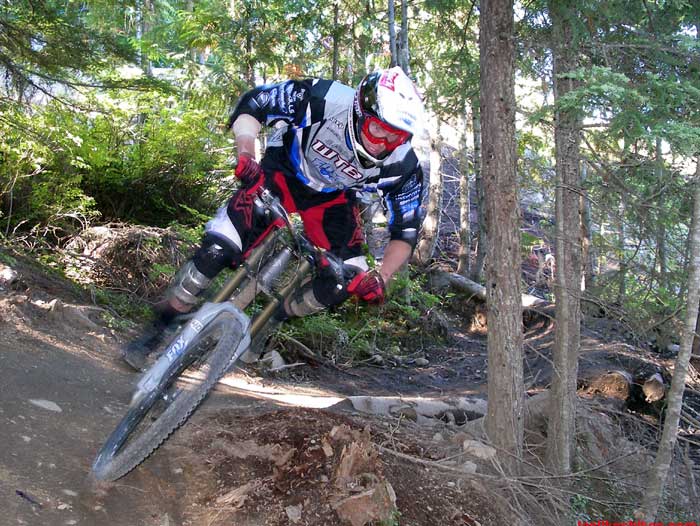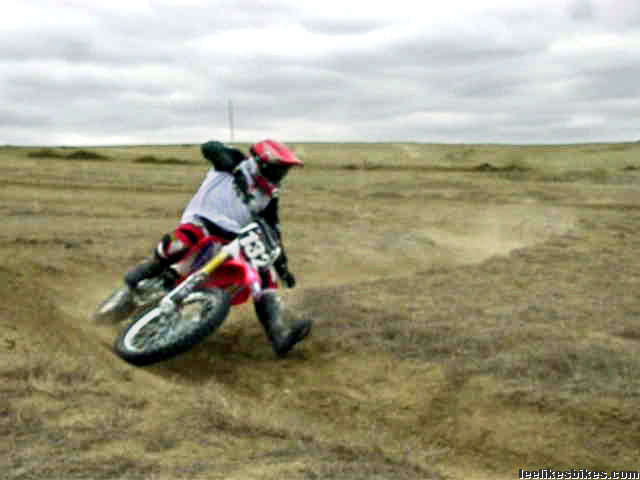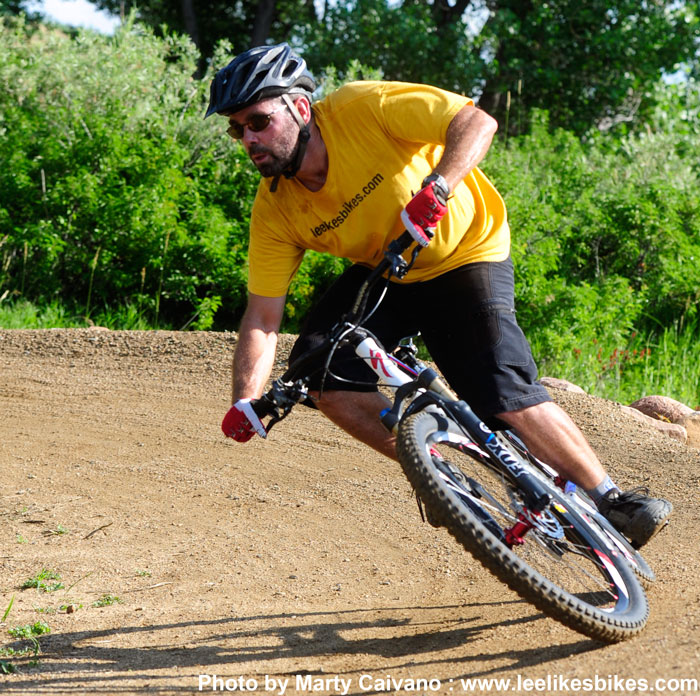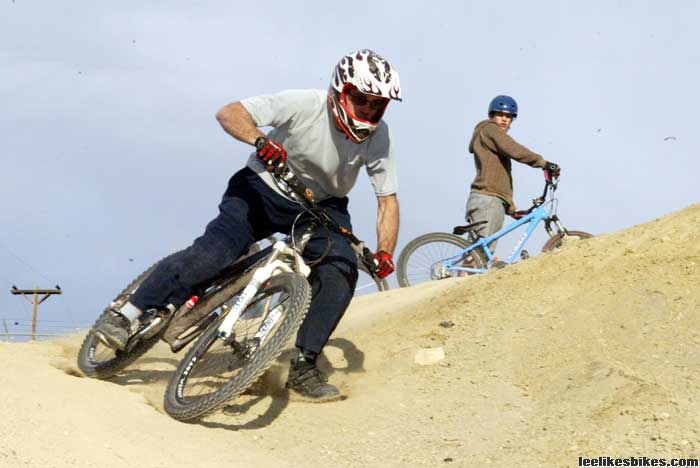DH riding style: Moto vs. MTB

Hi Lee,
I’m lovin’ your new Teaching Mountain Bike Skills book. It goes over all the essentials in really thorough point by point detail. The section on the attack position is a thing of beauty.
I really like the points made about riding to always see and set yourself up for your next turn. I think this is an extremely effective way to use your vision on your bike and keep looking farther forward. I even have been implementing it while climbing, and it has improved my climbing and made me faster. By looking for the next corner you always have something in your mind to focus on, and forces you to keep your head up. My first few times doing this my eyes were literally sore by the end of the ride.
As a side note, when people refer to a style of dh riding as Moto-style, what exactly does that mean? How does it differ from mountain bike style?
Thanks,
MAX
Hey Max,
Thanks for your note, and your kind words about Teaching Mountain Bike Skills. Yeah man, that book takes analysis of body position to a new level.
Moto vs MTB style?
|
You can corner a moto with bike technique, but it sure works better with moto technique. Slide forward on the saddle, maybe extend your boot forward to further weight the front wheel. |
What a great question. I spent some great years riding moto on road, trail and tracks. This was before babies. I was impressed with how well a good moto or bike rider can ride the other, but also how the rider’s ultimate kung fu was limited by the different machine — and the need to develop some new skills/habits. I wanted to write a two-sided book: one side was MX for MTBers, the other side was MTB for MXers. The middle page would say, really big: BRAAAP!
As a matter of fact, check out Moto riding for an MTBer, Part 1,
Motos and bikes are similar (duh), but they’re also fundamentally different (duh). Things to consider:
• For the most part, motos are bigger and heavier.
• For the most part, motos have more suspension.
• On a moto, the rider grips the seat with his knees, and the moto and rider become a single mass. The wheels and suspension work the terrain.
• On a bike, the rider’s torso and head are the sacred cargo. The bike, hands and feet work the terrain. This is the core of my MTB teaching method.
• In general, a bike is ridden with both wheels working equally. On a moto, the rear wheel is likely to be drifting wide while the front wheel tracks.
• Motos, as you might have heard, have engines. This changes cornering dynamics and — when coupled with long wheelbases and big suspension — encourages riders to plow through stuff.
• The more suspension a bike has, and the more it’s set up for handling, the more you can ride it like a moto. This is one reason DHers often exhibit moto style, while XCers rarely do.
Curtis Keene has a moto style. He came into the sport with suspension, and he spends a lot of winter time on a moto.
While Curtis works terrain better than most of us, for the most part Curtis has a pretty square, firm style. |
Watch Curtis wring out out a Stumpumper EVO:
I have an MTB style. I came into the sport on a rigid bike, and my imploding shoulders force me to be smooth. But I’m not super rad, so let’s go with Brian Lopes. Lopes is a veteran BMX, DS, 4X, DH and XC racer and the current California CX champion. He rides a bike like a bike. He’s a great moto rider as well.
Brian rocks some 4X and trail:
Brian rocks some Ibi. Check out 1:37 for classic bike-style corner work:
There are as many riding styles as riders — and the top riders all look pretty darn good — but here are some generalizations.
A mountain bike rider with an effective MTB style is likely to:
|
Decent bike cornering technique. |
• Keep his torso low and limbs loose.
• Project his sacred cargo forward, while using arms and legs to work the terrain.
• Keep his body on the same plane while the bike moves up and down over things.
• In turns, lean the bike much more than the body.
• Stay balanced fore-aft in corners.
• Keep the feet on the pedals.
• Focus energy and control on the pedals and bottom bracket. Ride with both wheels equally.
• Strive to never hit anything. Always absorb, always pump.
A mountain bike rider with an effective moto style is likely to:
|
Even a bike nerd like me switches to moto style when I sense the front wheel needs more traction. |
• Have a relatively upright and firm riding position. Sam Hill.
• Stay firm (not stiff) in rough terrain, and let the bike do the work (aka plow through stuff). Keene shows this, even on a short-travel bike.
• Bounce his body up and down over obstacles.
• In turns, lean the bike and body somewhat together. Great suspension and tires help you get away with this.
• Weight the front end in corners. A) This increases front-wheel traction on a long, slack bike. B) It encourages the rear end to drift.
• Take the inside foot off the pedal. A skilled moto-style rider does not hang the foot to the inside like a tripod; he extends it forward to increase front traction.
• Focus energy and control on the front of the bike and encourage the rear wheel to do whatever.
• At the higher levels, a moto-MTB rider will purposely hit obstacles hard to load the suspension, then use the resulting unload to do cool things. A classic example is coming up short on a gentle double so he can get even more boost off the landing/takeoff.
• Yell BRAAAP!
Ideally, you’ll learn both styles then mix and match them according to the terrain, your bike and your mood.
Looking at Aaron Gwin, I’d say he has a basically moto style (duh, he was a pro MXer), but with definite hints of MTB style — especially his position and fluidity in rough terrain. That approach seems to work, at least at the World Cup level.
As a matter of fact, the best moto trail riders know how to blend the firmness needed to control their machine on a prepped MX track and the fluidity to deal with crazily varying terrain. Modern DH seems similar.
Other MTB riders who mix styles depending on the situation include:
• Gee Atherton
• Mark Weir
• Curtis Keene
• Brendan Fairclough. Watch this video of him and Keene riding. They share the same basic approach, but a keen eye can spot Brendan switching modes in the tighter sections.
• And, of course, Danny Hart. You’ve all seen his world championship-winning downhill run. What a beautiful combination of firmness and fluidity. Watch how he intentionally hits some things and absorbs others.
Whoa, this just same online today. Chris Kovarik mixes styles — and tears Whistler a new one, metal style.
I hope this is helpful. What do y’all think?
Braaap!!!
Lee
Know more. Have more fun!
Join the leelikesbikes mailing list:




Comments are closed.